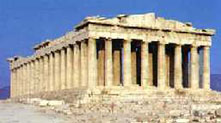Fifth-century Athens

- Aerial view of the Acropolis at Athens
Historically Athens has received much of the credit for keeping Greece from becoming part of the Persian Empire. The fifth century was her finest period, documented in contemporary literature, which has survived, and celebrated in monumental art which has also survived; the most famous example is the Parthenon. The fifth century, and late sixth, was also the period when the best pottery was made. What set it apart was the richness of the narrative, technical precision, and a fine sense of aesthetic design.

- View of the Parthenon from the north-west
Athens' own aspirations to empire were dashed at the end of the fifth century, after she entered into a disastrous conflict with her rival Sparta, which is also documented in contemporary literature. Economically she seems to have recovered quite quickly, but great artists had already gone elsewhere for patronage. Pottery production also suffered. Overall the quality of shape and technique of decoration tended to decline, leaving us with the impression that fine painting was being executed on walls, no longer on pottery.
The relation between Greek painting and Greek pottery has intrigued scholars for a long time. Greek pottery, even the finer with figure decoration, has been preserved in quantity. Today more than 100,000 examples of Athenian, from 600 to 300 BC, are kept in museums and private collections worldwide. Greek painting, on the other hand, from 1000-300 BC has scarcely survived. There are wall-paintings from Bronze Age palatial structures and tomb-paintings from later 4th century Macedonia, but precious little from mainland Greece. The naming of wall-painters in ancient literary sources, the description of the subject-matter of famous paintings, and discussions of the techniques make it irresistible for scholars to seek glimpses of this lost art.





